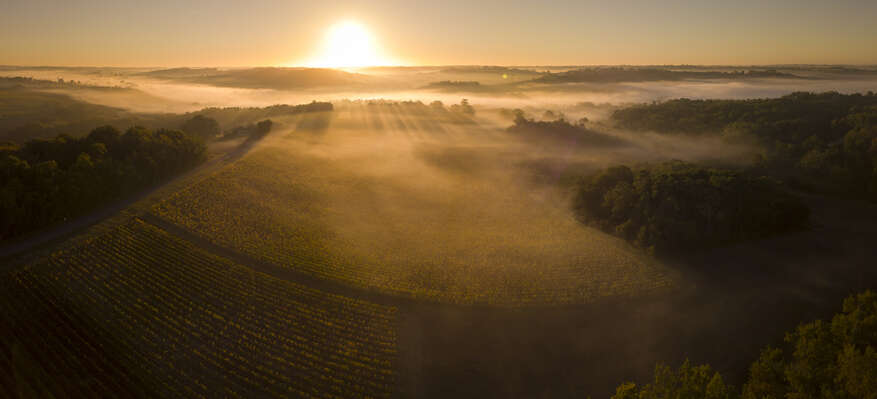
In the latest dispatch from his Bordeaux 2021 en primeur tasting trip, Simon Field MW reports from Sauternes, where winemakers are doing their best to transcend a very difficult set of circumstances.
Sauternes today is not enjoying the best of times.
Nature’s caprice means that some blights are more welcome than others.
The somewhat perverse (paradoxical at least) phenomenon of noble rot is fundamental to its existence.
Others, mildew and frost key amongst them, are potentially disastrous.
And there was plenty of frost in the early Spring of 2021, so much so that two-thirds of the châteaux from 1855’s Classification felt disinclined to make any sweet wine, which, for a lot of them, meant absolutely no wine at all.
Not so much disinclined as disenfranchised by the stark reality of prospective and, as it turned out for the courageous few, actual average yields of 3 hl/ha, the frost doing its worst in both the clay of Barsac and the limestone of Sauternes.
Nowhere was spared. The proximity to the confluence of both the Garonne and its smaller tributary the Ciron, the very thing in other words which provokes the wondrous noble rot later in the season, in the Spring can bear significant responsibility for disastrous and near ubiquitous frosts.
April is the cruelest month, as our poets remind us.
Staying stoical in Bordeaux 2021
Jean-Jacques Dubourdieu at Château Doisy-Daëne is stoical.
As the recently appointed President of the AOCs of Sauternes and Barsac, he does not want to endanger further migration from the Sauternes category and decided to make his wine, come what may.
Not much wine at the end of the day and I’m not sure if “loss leader” featured in his thoughtful explanation, but the sentiment was clear. The show must go on.
And what a show it has proved to be! Nature taketh away but nature also giveth, and in the minute crop of 2021 we have been given some wonderful wines: botrytically (sic) pure (a delicious oxymoron), fresh, flavorsome, long, and almost uniformly harmonious.
There is no specific correlation between frost and/or mildew and botrytis, physiologically speaking.
The lackluster conditions in the middle of the season, however, which were so infelicitous for the red varietals elsewhere in Bordeaux, were actively conducive to the progress of the botrytis.
The upshot has been wines of focus and purity and, as so often with cooler years, wines with a real sense of place.
The difference between Barsac and Sauternes itself could not be clearer, between Coutet, say, and Suduiraut.
It’s just that not many of us will get to try them. Dommage!
So while Jean-Jacques at Doisy-Daëne, as phlegmatic as his namesake Monsieur Rousseau, persevered with his wine, his maybe more objective and realistic neighbor Guillaume Lefebvre at Château Doisy-Védrinnes made nothing at all.
A pure, cold commercial inevitability, nothing else.
I was, however, not entirely disappointed during my visit when Guillaume took it upon himself to treat me to a mini-vertical, including the 2001 and the 1989, magisterial both.
The 2021 would probably have turned out like that one, he shrugs, pointing at the half bottle of 2001. Probably.
Hard times for Bordeaux sweet wines
So hard times in Sauternes, at odds seemingly with the gentle landscape and the tableau of photogenic wineries.
“We all need to pull together,” says Jean-Jacques, “and we need to diversify too.”
Hard to do when one’s reputation has been built on a famously static hierarchical taxonomy—the reception, for example, given to the region’s dry white wines has been mixed to say the least.
Broader diversification, then.
The hotel’s restaurant at Lafaurie-Peyraguey has recently won its second Michelin star; there are other hotels planned at D’Arche and Giraud; and there is talk of a multi-media centre in the village of Barsac (hard to imagine in today’s sleepy hamlet but you never know).
And there is more. What about Sauternes-based cocktails at La Tour Blanche and summer soirées in the vineyard which go on late into the night?
Miguel Aguirre takes me to see Tour Blanche’s panoramic vantage point; we marvel at the spiraling buzzards and admire the spires of both Barsac and Sauternes and, almost hidden by trees, of Bommes too, a gentle, verdant, landscape, recalling Constable’s Dedham Vale: everything is so peaceful and so composed.
Sauternes may not be quite ready for midnight bacchanalia and a high-tech enotourism centre, I think to myself quietly.
But one cannot fail to be impressed by the positive spirit at play, by the esprit de corps and by the resilience in the face of such diverse challenges.
Quality (if not quantity) will out, God willing. This has been the story of Sauternes all the way back to 1855, and beyond.
2021 Château Doisy-Daëne Premier Cru Classé, Sauternes
(86% Semillon / 14% Sauvignon Blanc)
Relatively pale, with a slight green tint, reticent at first with youth most definitely on its side. A touch closed, maybe too cold, but not for long: spring flowers and the exotic, waxy, contrarian voices of botrytis take hold; very promising.
The palate builds with similar rigor, vanillin puppy fat soon ceding to noble rot’s more complicated legacy; sweet and savory harmonious only because of the disciplined grip of the firm line of acidity, 2021 parsed to perfection, and steadfast to the very end. Less gives more…
Bordeaux 2021 coverage
Bordeaux 2021 en primeur: Romance and reality
Bordeaux 2021 Field Notes: Château Figeac
Bordeaux 2021 Field Notes: Vieux Château Certan
Bordeaux 2021 Field Notes: Château Pavie
Bordeaux 2021 Field Notes: Le Dôme
Bordeaux 2021 Field Notes: Domaine de Chevalier
Bordeaux 2021 Field Notes: Sauternes and Barsac
Bordeaux 2021 Field Notes: Pichon Lalande
Bordeaux 2021 Field Notes: Enquiring Minds
Bordeaux 2021 Field Notes: The Whites Have It






